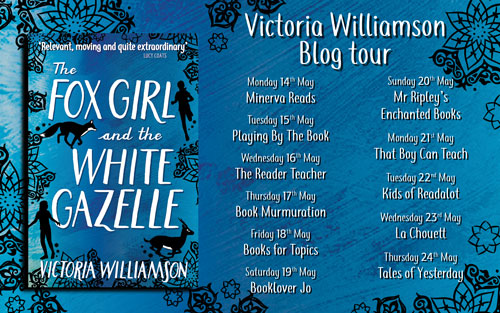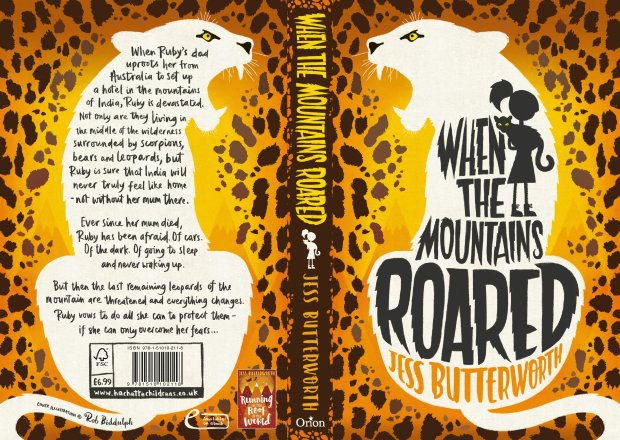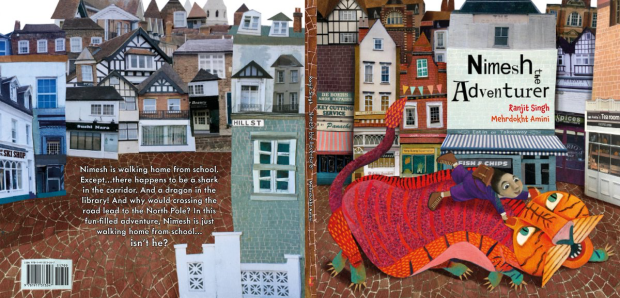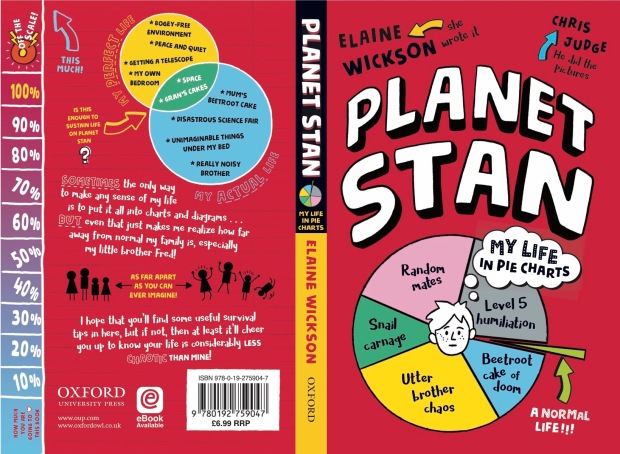
‘A truly transformational read. Intensely powerful and immensely poignant at the same time… such a groundbreaking, essential and accomplished debut that not only changes perceptions but also has the power to alter attitudes. With this one, Victoria has most certainly made herself a writer to watch.’
Rating: ⭐ ⭐ ⭐ ⭐ ⭐
Title: The Fox Girl and the White Gazelle
Author: Victoria Williamson (@StrangelyMagical)
Illustrator (Cover): @FlorisBooks
Publisher: Kelpies (@DiscoverKelpies)
Page count: 272
Date of publication: 19th April 2018
Series status: N/A
ISBN: 978-1782504900
Perfect for Year 5, Year 6 & Year 7.
#3Words3Emojis:
1. Friendship 👭
2. Courage 💪
3. Empathy ☺️
She is the Fox Girl.
I am the White Gazelle.
Together we can outrun anything.
Reema feels completely lost. She’ll never call this strange country, with its grey skies and boring food, home. Syria is her home and it’s a million miles away.
Caylin feels completely alone. She’s looking after he useless mum, stealing from other kids so she can eat. She can’t tell anyone, they’ll only let her down.
The refugee and the bully – Reema and Caylu – can’t imagine being friends, until a shared secret brings them together.
The first line(s):
Growls in the dark: the monsters are coming /
The home time bell’s so loud it hurts my head.
Review:
Switching between the chapter-changing perspectives of the two main characters, Caylin (who’s used to the streets of Drumhill) and Reema (who’s more used to the streets of war-torn Aleppo), this is a truly transformational read.
There’s not much that these girls can seem to be smiling about as their home lives are somewhat rocky with a mix of domestic depression, alcoholism and wondering where the next meal is coming from for Caylin and culture shock, a language barrier and a complete fear of the unknown for Reema.
However their lives change forever when they both discover a family of foxes. Though it’s this shared secret that initially brings them together to form an unexpected friendship that sometimes boils over yet blossoms, they end up sharing far more than even they could begin to imagine…
With two main characters that are polar opposites of each other: one seemingly damaged by the aftermath of war, the other damaged by circumstance; we see them mature and develop throughout the course of the book. This stunning story gives a voice to characters who, in the world we live in today, so often don’t have a voice and it is in their own words and Victoria’s own experiences working with young asylum seekers that she captures both characters’ voices so clearly and convincingly that they really come to life on the pages before your very eyes.
Bringing the most unlikeliest of friends together, especially this pair, is a difficult thing to do. Yet, Victoria really intertwines these two characters’ lives so pertinently that their storylines fit together in a way that seems that they were always destined to meet each other and bring out the best in each other.
Shortlisted for the @TeachPrimary Book Awards, this is such a groundbreaking, essential and accomplished debut that not only can change perceptions but also has the power to alter attitudes. It is intensely powerful and immensely poignant at the same time; hitting hard when it needs to whilst tenderly tugging at those heartstrings of yours too.
Overall, it’s a wonderfully well-voiced story from both sides as it’s a touching yet timely reminder of the world in which we live in and how with thought, feeling, compassion and togetherness, we can all live a better life as Jo Cox said, ‘we have far more in common than that which divides us‘.
A book to be proud of writing for Victoria and a book to be proud of reading for all of us. With this one, Victoria has most certainly made herself a writer to watch.
Books can change lives and this just might be one of those books.
One of my favourites of the year so far.
‘A truly transformational read. Intensely powerful and immensely poignant at the same time… such a groundbreaking, essential and accomplished debut that not only changes perceptions but also has the power to alter attitudes. With this one, Victoria has most certainly made herself a writer to watch.’
Big thanks to Victoria & Kelpies/Floris Books for sending me an advance copy of this wonderfully written book!
The Fox Girl and the White Gazelle is available to order now online or from any good bookshop.
Mr E
📚

Mirrors and Doors
‘Books are sometimes windows, offering views of worlds that may be real or imagined, familiar or strange. These windows are also sliding glass doors, and readers have only to walk through in imagination to become part of whatever world has been created or recreated by the author. When lighting conditions are just right, however, a window can also be a mirror. Literature transforms human experience and reflects it back to us, and in that reflection we can see our own lives and experiences as part of the larger human experience. Reading, then, becomes a means of self-affirmation, and readers often seek their mirrors in books.’ Rudine Sims Bishop, Ohio State University, ‘Mirrors, Windows and Sliding Glass Doors’.
Most teachers know that books can act as magical doorway to other worlds. But how many of us stop to consider the importance of providing not just doors for children to explore, but mirrors to reflect their own life experiences?

The first time I realised that not all stories were universal was when I was working as a VSO teacher in Cameroon. One of my duties was helping develop the small school library, stocked with donated books from the UK and the USA. During a reading lesson with a ten year old who was struggling with literacy, I picked out The Ugly Duckling as a story with fairly easy language. After twenty minutes’ hard slog, we hadn’t got past the first paragraph. We had to keep stopping so I could explain what a duckling was. Then a pond. Then a swan… We gave up and tried other stories, but with no more success. After months of encouraging children to borrow books from the library, only to see their initial enthusiasm give way to apathy, I finally discovered the problem. Those western reading books, despite their bright covers and illustrations, held no relevance for the children. Their stories of ice cream, snowmen, fireworks, and Santa Claus might as well have been written in a foreign language. They were not mirrors reflecting the children’s own experiences of growing up in a small West African village with limited access to electricity and an unreliable water supply, and they couldn’t act as doors to new worlds either, as the children lacked the information keys to unlock those worlds. It wasn’t until I sought out books written by West African writers which featured children growing up in villages like Nkambe, that the library really took off. Children flocked to borrow stories by Chinua Achebe, Mabel Segun and Kola Onadipe featuring characters just like themselves, and their reading abilities began to gradually improve.

That was when I first began to understand the power of diverse books. Looking back I realised the stories I’d loved as a child had been dominated by white, middle class, able-bodied characters, which were not representative of the children from the many diverse backgrounds with various special needs that I was teaching as an adult. This had resulted in me recreating the ‘standard’ characters in my own writing, and the stories often fell short of their potential due to the restrictions I placed on them without even realising it.
Travelling, teaching, and reading more widely led me to experiment with a far greater variety of characters in my own novels. The characters in The Fox Girl and the White Gazelle are composed of many voices. Caylin, a troubled twelve-year-old struggling with her mother’s alcohol addiction in a Glasgow council estate, and Reema, a Syrian Muslim refugee whose world has been turned upside down by war, were inspired by some of the children I have taught over the years.
No one is saying we shouldn’t read the classic children’s books in schools – my own imaginative landscape would be infinitely poorer without the wonderful Enid Blyton, Narnia and Harry Potter books. But if the books in a classroom library act only as mirrors for one type of experience – often white, middle class, able-bodied and frequently male – then many children will not only find opaque glass where their mirrors should be, but the doors to new worlds locked and the keys missing.
As teachers we need to be aware that when selecting books to be read in our classrooms, we are choosing which children get to see reflections of themselves in heroic roles. We are also acting as the gatekeepers to exciting new worlds, and we need to ensure that some children are not denied access due to a lack of representation. Have a look right now at the books in your school library and the ones you plan to teach. Are there a wide range of experiences reflected in them? Do they invite all children to share the adventure? If they do then they’re not just books, but mirrors and doors for all of your children to explore literature together.

Victoria Williamson is a primary school teacher with a Master’s degree in special needs education. She has worked as a science teacher and teacher trainer in Cameroon and Malawi, an English as a foreign language teacher in China, and as a special needs teacher in the UK.
Victoria has been writing fiction since she was a child, and now writes full time for Middle Grade and YA, with a particular focus on creating diverse characters reflecting the many cultural backgrounds and special needs she has encountered, both as a teacher and as a volunteer. Having worked with children in Africa, Asia and across the UK with additional support needs such as Autistic Spectrum Disorder, Down’s Syndrome, physical disabilities and behavioural problems, Victoria is passionate about creating inclusive worlds in her novels where all children can see a reflection of themselves in heroic roles.
Victoria’s experiences teaching young children in a school with many families seeking asylum inspired her debut novel, The Fox Girl and the White Gazelle, an uplifting tale of redemption and unlikely friendship between Glaswegian bully Caylin and Syrian refugee Reema. Twenty per cent of author royalties for ‘The Fox Girl and the White Gazelle’ are donated to the Scottish Refugee Council.
You can find Victoria on Twitter as @strangelymagic or on her website.
Giveaway!
Victoria has very kindly given me two copies of The Fox Girl and the White Gazelle complete with matching model toy (of fox or white gazelle!) to give away to two lucky winners!
If you’d like to be in with a chance of winning one of these copies of this superb book and complementing model toy, simply retweet (RT) this tweet!



Be sure to check out the other blog tour dates for The Fox Girl and the White Gazelle!







 Review:
Review: Recently, I attended an event where I had the pleasure of hearing triple laureates, Lauren Child (
Recently, I attended an event where I had the pleasure of hearing triple laureates, Lauren Child (
















